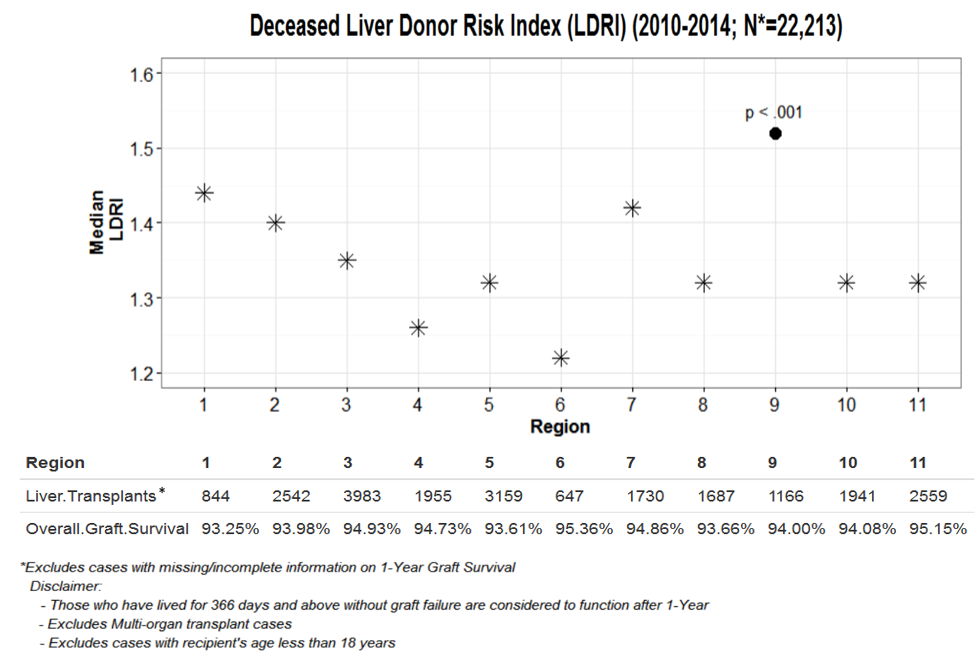Regional Variation in Liver Donor Utilization Across the U.S.
1LiveOnNY, New York, NY
2Binghamton University, Binghamton, NY
3Recanati/Miller Transplant Institute, New York, NY
4Weill Cornell Medical College, New York, NY
Meeting: 2017 American Transplant Congress
Abstract number: C186
Keywords: Allocation, Donation, Liver transplantation, Waiting lists
Session Information
Session Name: Poster Session C: Organ Allocation, Meld Score, Organ Utilization, and Transplant Outcomes
Session Type: Poster Session
Date: Monday, May 1, 2017
Session Time: 6:00pm-7:00pm
 Presentation Time: 6:00pm-7:00pm
Presentation Time: 6:00pm-7:00pm
Location: Hall D1
Unequal patient access to deceased donor liver transplantation across the U.S. has generated efforts to redesign the allocation system. Geographic disparities include the severity of illness, recipient waiting time, and likelihood of death without transplantation.
National data was accessed through the National UNOS STAR file (June 2016) to determine the Liver Donor Risk Index (DRI) that provides a quantitative assessment of the risk of donor liver graft failure for all deceased donor liver transplants performed from 2010-2014. Utilization patterns and 1 year graft survival were analyzed by UNOS region.
Sufficient data was available to assess 22,213 transplants. DRI ranged from 0.8 to 3.1. Graft survival ranged from 93.3% to 95.4% which did not vary significantly by region (multiple proportions test). During this period the national median DRI rose significantly. The median DRI varied significantly by region (1.23 – 1.53) with region 9 having a higher DRI than any other region (permutation test). The liver DRI is determined from donor demographic data + the cold ischemic time (which was shorter in region 9 than other regions). Utilization of relatively high risk donors (high DRI) is not equivalent throughout all regions. It is likely that more aggressive efforts to facilitate liver transplantation from relatively more marginal quality donors in those regions with low median DRIs can be accomplished without compromising recipient survival at 1 year (which did not vary across regions). Increased utilization of high DRI liver donors in those regions is likely to increase the total number of available liver grafts and reduce deaths on the national waiting list.
The liver DRI is determined from donor demographic data + the cold ischemic time (which was shorter in region 9 than other regions). Utilization of relatively high risk donors (high DRI) is not equivalent throughout all regions. It is likely that more aggressive efforts to facilitate liver transplantation from relatively more marginal quality donors in those regions with low median DRIs can be accomplished without compromising recipient survival at 1 year (which did not vary across regions). Increased utilization of high DRI liver donors in those regions is likely to increase the total number of available liver grafts and reduce deaths on the national waiting list.
CITATION INFORMATION: Friedman A, Bagavan P, Florman S, Irving H, Samstein B, Schleich B. Regional Variation in Liver Donor Utilization Across the U.S. Am J Transplant. 2017;17 (suppl 3).
To cite this abstract in AMA style:
Friedman A, Bagavan P, Florman S, Irving H, Samstein B, Schleich B. Regional Variation in Liver Donor Utilization Across the U.S. [abstract]. Am J Transplant. 2017; 17 (suppl 3). https://atcmeetingabstracts.com/abstract/regional-variation-in-liver-donor-utilization-across-the-u-s/. Accessed December 29, 2025.« Back to 2017 American Transplant Congress
